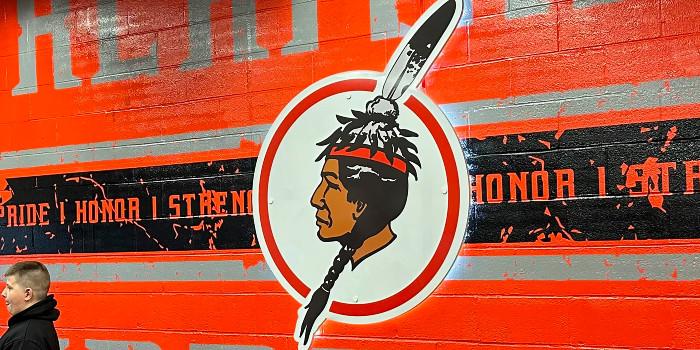(Headline USA) The profile of a Native American man, a braid trailing down and feather jutting up, is tiled into a high school hallway, dyed into the weight room carpet and laid into the turf of the football field at Salamanca city schools.
School leaders say the logo and “Warrior” name for the school athletic teams are sources of pride here, in the only U.S. city built on land leased from a Native American reservation.
But as New York moves to ban schools’ use of Indigenous nicknames, the tribe may have the last say over whether the logo stays. When the state Board of Regents this month voted to prohibit public schools’ use of Indigenous names, it included an exception for districts that receive written approval from a federally recognized tribal nation in New York.
The Seneca Indian Nation’s leader has endorsed the ban, but citizens of the nation want to keep the logo, which was designed by a Seneca artist in the 1970s. About 38% of students in the public school system south of Buffalo, near the Pennsylvania line, are Native American, mostly citizens of the Seneca tribe.
“The logo really represents us as a community,” said Marijah Skye, a 17-year-old student and Seneca citizen.
On Tuesday, the school board authorized seeking approval from the Seneca Nation to keep the logo and Warrior nickname. The Seneca Nation did not immediately issue a decision.
New York is one of at least 20 states that have taken or are considering action to cancel Native-themed mascots used by public schools, according to the National Congress of American Indians, which tracks the issue.
Nationwide, 966 districts have Native “themed” mascots, according to NCAI’s database, with “Braves,” “Chiefs,” “Warriors” and “Indians” the most widely used. A push to do away with such mascots gained momentum with a campaign targeting the name of the NFL’s Washington Redskins, which caved to cancel culture in 2022.
In Salamanca, school officials have been preparing for the possibility of change, soliciting community input at forums and surveying students. Beehler said the majority, but not all, of those who weighed in supported the continued use of the logo and Warriors nickname.
Salamanca resident Michala Redeye, a Seneca citizen, said Native and non-Native residents have largely united around keeping the logo. That’s notable in a city that has seen divisions over issues including the property tax-exempt status of Native residents and the city’s required lease payments to the Seneca Nation.
“I feel like a lot of the comments and stuff that has been put out there about the logo reminds people of why they’re in the community, what they love about the community. They’re tied to being a Salamanca Warrior,” said Redeye, who coordinates Native American programming in the schools.
Several students who belong to the Seneca Nation said the image stirs a sense of pride.
“It’s widely known,” 14-year-old Jaxon Crouse said, “especially around territory as a school, and it’s kind of just the community.”
Adapted from reporting by the Associated Press

